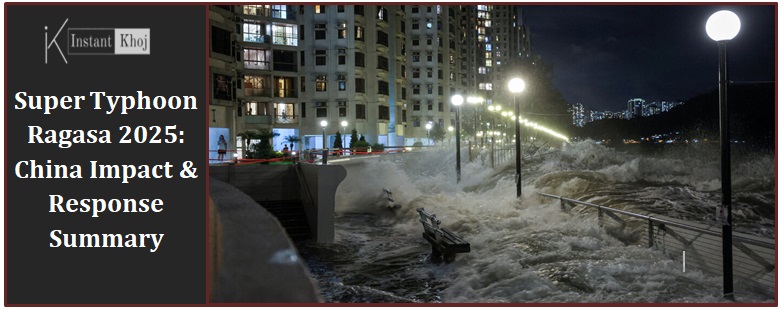On September 24, 2025, Super Typhoon Ragasamade landfall in southern China, primarily impacting Guangdong Provinceafter sweeping through the Philippines, Taiwan, and Hong Kong. As one of the most powerful storms of the year, Ragasa tested China’s disaster preparedness and response systems on a massive scale.
Marked by extreme winds, torrential rains, and widespread flooding, Ragasa caused massive evacuations, disrupted infrastructure, and exposed vulnerabilities in urban planning and emergency management.
Formation and Path
Ragasa began as a tropical disturbance in mid-September, quickly intensifying due to warm sea surface temperatures and favorable atmospheric conditions.
-
September 17: Designated a tropical depression.
-
Following days: Strengthened rapidly into a super typhoon.
-
September 22: Monitored closely by regional weather agencies.
-
Track: Moved northwest through the South China Sea, maintaining intensity as it approached the Chinese coast.
Forecasts projected landfall along Guangdong’s coast between September 23–24, with potential heavy rainfall reaching further inland.
Early Warnings and Preparations
Recognizing Ragasa’s severity, Chinese authorities responded swiftly with large-scale precautionary measures.
Emergency Declarations
-
On September 23, a Level IV emergency response was activated across Guangdong, Hainan, and Fujian.
-
Guangdong later raised its status to Level II—the second-highest level—due to growing threat levels.
Evacuations and Closures
-
Shenzhen relocated 400,000 residents.
-
Province-wide, over 1.04 million people were moved to safe areas by the evening of September 23.
-
Final tally of evacuees: 1.9 million people.
-
Businesses, markets, schools, and transport services in at least 10 cities were suspended.
Maritime and Infrastructure Measures
-
Over 80,000 fishing boats were recalled to port.
-
Coastal defenses, bridges, drainage systems, and vulnerable structures were inspected and reinforced.
-
Public awareness campaigns were conducted to ensure citizens were prepared.
Resource Allocation
The central government dispatched essential relief supplies—tents, quilts, emergency kits, and lighting equipment—to regional disaster response centers in anticipation of large-scale impact.
Landfall and Immediate Impact
At approximately 5:00 p.m. on September 24, Ragasa made landfall on Hailing Island (part of Yangjiang city), with maximum sustained winds of 144 km/h.
-
In Chuandao town, gusts reached 241 km/h—the strongest ever recorded in that area.
-
Though the storm weakened after landfall, it delivered destructive rain, flooding, and storm surge across multiple provinces.
Wind, Rain, and Storm Surges
-
Rainfall reached up to 280 mm in parts of Guangdong and Fujian.
-
Coastal storm surges inundated low-lying districts, promenades, and roads.
-
Cities like Zhuhai experienced crashing waves, inland sea spray, and waterfront flooding.
-
Inland rivers overflowed, causing significant urban flooding and transportation disruptions.
Damage to Infrastructure and Property
-
Trees were uprooted, roads flooded, and walls collapsed.
-
Power outages spread across multiple cities.
-
Coastal buildings and homes suffered water and wind damage.
-
Transportation—airports, highways, and rail—was shut down across several cities, including Hong Kong, which saw over 700 flights canceled.
Impact on Hong Kong and Macau
Though not on mainland China, Hong Kong and Macau were significantly affected as Ragasa approached.
-
Hong Kong raised the Typhoon Signal No. 8, triggering widespread shutdowns.
-
City streets, subways, and coastal roads were flooded.
-
Electrical and transit systems were disrupted.
-
Residents were urged to shelter indoors, and emergency shelters were activated.
Emergency Response and Relief Efforts
China’s post-landfall response was swift and large in scale.
Mobilization of Resources
-
Thousands of emergency personnel were deployed for rescue, evacuation, and infrastructure clearance.
-
Relief materials—tents, food, lights, sanitation supplies—were distributed in affected zones.
Government Aid
-
150 million yuan in relief funds was allocated for Guangdong, Hainan, and Fujian.
-
Restoration of electricity, transportation, and communication services began within hours of landfall.
The proactive evacuations and planning are widely believed to have significantly reduced casualties and long-term damage.
Exposed Vulnerabilities and Challenges
Despite substantial preparation, Ragasa revealed multiple weaknesses in disaster readiness:
1. Rapid Intensification and Forecasting Challenges
The storm’s quick strengthening made it difficult for agencies to provide long lead times in some areas.
2. Flood Control and Infrastructure Strain
Drainage systems and flood defenses were overwhelmed in multiple cities. Inland flooding occurred due to saturated rivers and blocked urban drainage.
3. Evacuation Logistics
Moving nearly 2 million people tested coordination between government agencies and local communities, particularly in rural or poorly connected areas.
4. Economic Disruption
Temporary closure of businesses, factories, and transport services had a ripple effect on manufacturing, agriculture, and supply chains—especially in Guangdong, a major economic hub.
5. Post-Disaster Health Risks
Floodwaters raised risks of waterborne disease, infrastructure hazards, and sanitation breakdowns. Access to clean water and medical care became a concern in some regions.
Key Lessons and Recommendations
Ragasa offers critical insights for China and other countries facing intensified tropical cyclones:
Early Warning Systems
-
Improve storm modeling, real-time data analysis, and public communication—especially in rural areas.
Climate-Resilient Infrastructure
-
Upgrade sea walls, flood barriers, and drainage networks.
-
Introduce resilient building codes in typhoon-prone regions.
Urban and Land-Use Planning
-
Limit construction in flood-prone zones.
-
Promote sustainable urban development on higher ground.
Integrated Response Systems
-
Strengthen coordination across meteorological, emergency, local, and national agencies.
Public Awareness
-
Increase community engagement and preparedness drills to ensure timely evacuation and response.
Post-Storm Recovery Frameworks
-
Implement rapid funding, insurance support, and mental health resources for affected populations.
Frequently Asked Questions (FAQs)
Q1: When did Typhoon Ragasa form and hit China?
Formed on September 17, 2025; made landfall in China on September 24, striking Yangjiang, Guangdong.
Q2: How powerful was it?
Sustained winds at landfall were 144 km/h, with gusts up to 241 km/h in some locations.
Q3: How many people were evacuated?
Approximately 1.9 million people across Guangdong Province.
Q4: Which areas were hardest hit?
Coastal cities including Yangjiang, Jiangmen, Zhuhai, and Shenzhen, along with parts of Hong Kong and Macau.
Q5: Were there any fatalities?
Fatalities in China are still being confirmed. At least 17 deaths occurred in Taiwan, mainly due to flooding and infrastructure collapse.
Q6: What are the economic losses?
Still being assessed, but expected to be significant due to infrastructure damage, business losses, and supply chain interruptions.
Q7: Did the preparation efforts help?
Yes—early evacuations, resource mobilization, and shutdowns greatly reduced casualties and damages.
Q8: How does Ragasa compare to other major typhoons?
Comparable to Typhoon Mangkhut (2018) and Hato (2017) in terms of wind strength and storm surge potential.
Q9: What are the long-term implications?
Ragasa highlights the growing risk of more frequent, intense storms due to climate change, reinforcing the need for adaptation.
Q10: What lessons can other countries learn?
- Prioritize early evacuation
-
Build resilient infrastructure
-
Improve forecasting and response coordination
Conclusion
Super Typhoon Ragasa brought extreme weather and widespread disruption to southern China, making it one of the most significant natural disasters of 2025. Thanks to large-scale mobilization, timely evacuations, and effective emergency coordination, the human cost was lower than it could have been. However, Ragasa also exposed structural and logistical challenges that must be addressed.
As climate change continues to intensify weather patterns, Ragasa serves as both a warning and a lesson. Proactive disaster planning, infrastructure investment, and community awareness are not optional—they are essential for survival in an era of extreme weather.
Also Read:
Khyber Pakhtunkhwa Airstrike: 30 Lives Lost, Details Inside!
FollowCurrent AffairsonInstantkhoj for more latest stories and trending topics.




